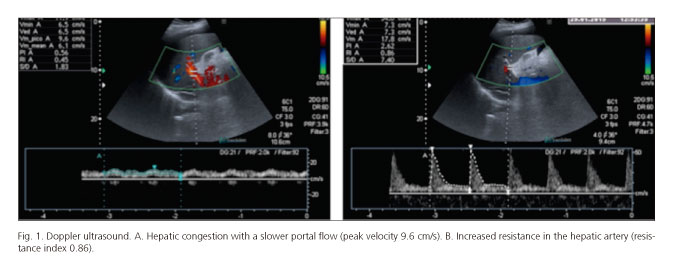My SciELO
Services on Demand
Journal
Article
Indicators
-
 Cited by SciELO
Cited by SciELO -
 Access statistics
Access statistics
Related links
-
 Cited by Google
Cited by Google -
 Similars in
SciELO
Similars in
SciELO -
 Similars in Google
Similars in Google
Share
Revista Española de Enfermedades Digestivas
Print version ISSN 1130-0108
Rev. esp. enferm. dig. vol.109 n.8 Madrid Aug. 2017
https://dx.doi.org/10.17235/reed.2017.4823/2017
LETTERS TO THE EDITOR
Use of abdominal ultrasound in the diagnosis of hepatic sinusoidal obstruction syndrome (SOS) in a patient receiving a hematopoietic-cell transplant
Utilidad de la ecografía abdominal doppler en el diagnóstico del síndrome de obstrucción sinusoidal (SOS) en un paciente receptor de trasplante de progenitores hematopoyéticos
Key words: Sinusoidal obstruction syndrome. Abdominal doppler ultrasound. Hematopoietic-cell transplant.
Palabras clave: Síndrome de obstrucción sinusoidal. Ecografía abdominal doppler. Trasplante de progenitores hematopoyéticos.
Dear Editor,
We report the case of a 47-year-old male with multiple myeloma who had received three previous hematopoietic cell transplants (HCT). Due to disease recurrence, a new HCT was performed after an appropriate conditioning therapy. Two days later he presented with ascites, jaundice and hepatomegaly. The ultrasound findings were hepatosplenomegaly and moderate ascites. Doppler examination showed signs of hepatic congestion with a slower portal flow, increased resistance in the hepatic artery (Fig. 1) and decreased liver compliance with a single-phase wave of the suprahepatic veins. The diagnosis was confirmed by a transjugular liver biopsy that showed extravasation of red blood cells, edema and subendothelial fibrosis in the centrolobuliary veins. Treatment with defibrotide was initiated and the patient improved on a clinical and analytical level. Hepatic vascularization and perfusion also improved, the portal vein exhibited a normal diameter, and velocity and flow and the hepatic artery had a rate and resistance index without alterations.
Discussion
Sinusoidal obstruction syndrome (SOS) is an uncommon form of portal hypertension that occurs in HCT recipients who receive intense conditioning treatments (1). The diagnosis is clinical and it is established using the modified Seattle criteria (2). Histological confirmation is usually not needed (3), although it may be necessary in order to exclude other entities such as graft versus host disease or pharmacological toxicity. Doppler ultrasound revealed hepatic congestion (4). Although non-specific, in an adequate clinical and epidemiological context it may aid in the diagnosis of SOS. This disease has a mortality rate that reaches 90% in severe cases. Defibrotide is the only treatment (5) thus, given the high morbidity and mortality, prevention becomes a priority.
Marta Abadía-Barnó, Eva Marín-Serrano and Gloria Ruiz-Fernández
Department of Digestive Diseases. Hospital Universitario La Paz. Madrid, Spain
References
1. Dignan FL, Wynn RF, Hadzic N, et al. BCSH/BSBMT guideline: Diagnosis and management of veno-occlusive disease (sinusoidal obstruction syndrome) following haematopoietic stem cell transplantation. Br J Haematol 2013;163(4):444-57. DOI: 10.1111/bjh.12558. [ Links ]
2. McDonald GB, Sharma P, Matthews DE, et al. Venocclusive disease of the liver after bone marrow transplantation: Diagnosis, incidence, and predisposing factors. Hepatology 1984;4(1):116-22. DOI: 10.1002/hep.1840040121. [ Links ]
3. Rubbia-Brandt L. Sinusoidal obstruction syndrome. Clin Liver Dis 2010;14(4):651-68. DOI: 10.1016/j.cld.2010.07.009. [ Links ]
4. Fontanilla T, Hernando CG, Claros JC, et al. Acoustic radiation force impulse elastography and contrast-enhanced sonography of sinusoidal obstructive syndrome (veno-occlusive disease): Preliminary results. J Ultrasound Med 2011;30(11):1593-8. DOI: 10.7863/jum.2011.30.11.1593. [ Links ]
5. Zhang L, Wang Y, Huang H, et al. Defibrotide for the prevention of hepatic veno-occlusive disease after hematopoietic stem cell transplantation: A systematic review. Clin Transplant 2012;26(4):511-9. DOI: 10.1111/j.1399-0012.2012.01604.x. [ Links ]











 text in
text in 


